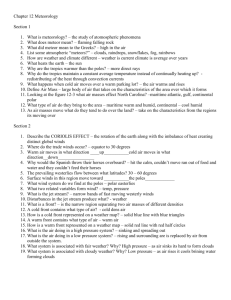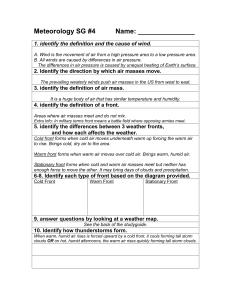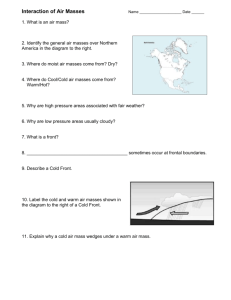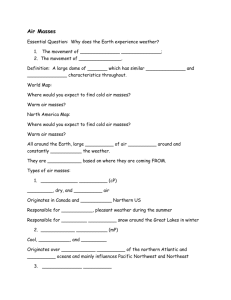Meteorology
advertisement
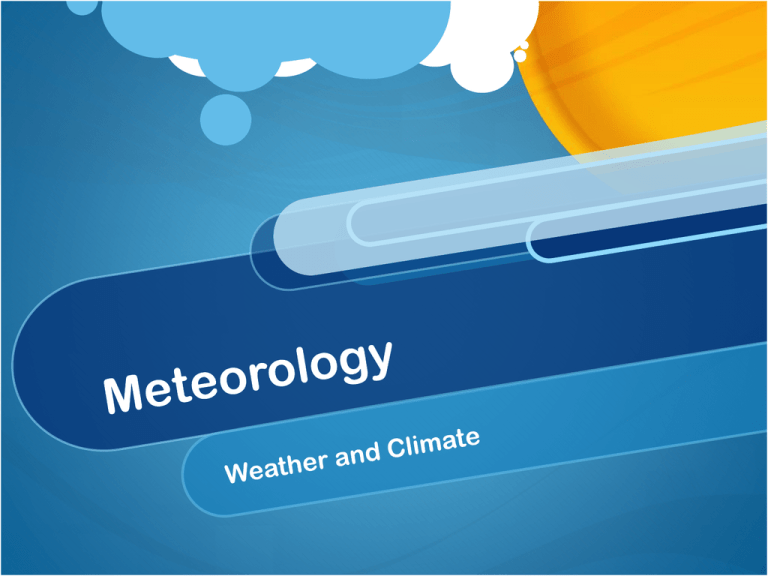
What is Meteorology? The study of atmospheric phenomena. WTH?!?! I thought a meteor was something that came from space?!?! In modern society, meteor pertains to a rock falling from space. In ancient Greece, meteor came from meteoros meaning “high in the air” Weather & Climate Weather Current state of the atmosphere Short-term variations in the atmosphere (hours) Climate Long-term variations in the weather for a particular area (years – decades) Compare/Contrast Weather Climate Lincoln’s high temp today is 62°F. Lincoln’s summer climate is hot and humid. It is sunny with a slight breeze today. The winters in Seattle, WA are wet, cold, and cloudy. The forecast for tomorrow is calling for half of an inch of rain. Nebraska has hot and humid summers, and cold and dry winters. What does the Sun have to do with anything? EVERYTHING!!! Solar Radiation The Sun heats the surface of the Earth. How is the radiation distributed throughout the planet? Solar Radiation What is the warmest time of the day? More direct rays in the afternoon Sun’s rays are more spread out at lower angles Same energy over a larger area Weather The heat from the solar radiation is redistributed throughout the globe Air and water movement Earth’s surface, oceans, and atmosphere This redistribution is what we call weather. Air Masses What is an air mass? Air Mass: Large body of air that takes on the characteristics of the area over which it forms. The area over which the air mass forms is called the source region. Air Masses Classification Continental Tropical (cT): warm and dry Maritime Tropical (mT): warm and humid Continental Polar (cP): cold and dry Maritime Polar (mP): cold and humid Arctic (A or cA): colder than cP Global Wind Systems Why is there wind? Convection Cells Why are there convection cells? Coriolis Effect Global Wind Systems Fronts What is a front? Region separating two air masses of different densities. Differences caused by temp, pressure, and humidity Thousands of kilometers long Interactions cause changes in weather Cold Front Cold, dense air displaces warm air, forcing it up along a steep front Clouds, showers, thunderstorms Warm Front Warm air displaces cold air Slower than cold front Cloudy, precipitation Stationary Front Two air masses meet, but neither advances Boundary stalls Temperature/Pressure difference between air masses is small Patterns reflect a warm front Occluded Front Cold air moves so fast that it overtakes a warm front, wedging the warm air upward. Precipitation High/Low Pressure Rising air is associated with low pressure Sinking air is associated with high pressure Coriolis effect causes rotation Pressure Systems High Pressure Air sinks, so it spreads away from center at surface Low Pressure Air rises, so air moves inward towards center to replace the rising air Factors that Influence Climate Air masses Proximity to water (think specific heat) Latitude (differential heating) Elevation/Altitude Albedo and Vegetation Ocean currents Topography
